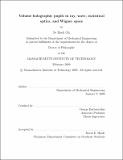Volume holographic pupils in ray, wave, statistical optics, and Wigner space
Author(s)
Oh, Se Baek
DownloadFull printable version (7.683Mb)
Other Contributors
Massachusetts Institute of Technology. Dept. of Mechanical Engineering.
Advisor
George Barbastathis.
Terms of use
Metadata
Show full item recordAbstract
This thesis explores various aspects of the volume holographic pupils to better understand and implement multi-dimensional imaging. A full description and applications of volume holographic pupils are presented in ray, wave, statistical optics, and Wigner space. Volume holograms have both a shift variant nature and multiplex capability, which can efficiently extract specific information of multi-dimensional objects by engineering imaging kernels with shift variant point spread functions and using post-processing. Based on the k-sphere formulation, an efficient computation method of analyzing volume diffraction is developed. It is integrated with the ray tracing software ZEMAXr whose built-in analysis and optimization features provide a great versatility for analysis, design, and optimization of novel volume holographic imaging systems. For a plane wave reference hologram, the shape of the Bragg diffraction image is analyzed in detail, where the shape is a distorted ellipse. The wave optics formulation of volume diffraction is revisited and further developed into statistical optics. The partially coherent response of a volume holographic imaging system is derived. Based on spatial coherence measurements, new passive binary depth detection is proposed, which is a special case of multi-dimensional imaging. Spatially incoherent two objects at two distinct depths are discriminated: focused objects in the foreground and defocused objects in the background. The passive detection is demonstrated for featureless uniform objects under quasi-monochromatic light by measuring mutual intensity with a volume holographic imager. By exploiting cross spectral density measurement, the passive binary depth detection is also demonstrated under white light illumination. Finally, the Wigner distribution function for volume holographic pupils is introduced.The space-spatial frequency characteristics of volume holograms are analyzed with linear systems approach. Wigner representations of two volume holograms are examined: plane and spherical wave reference holograms. Then, various axial imaging systems, which measure the depth of objects from intensity images, are explored by the Wigner analysis. Two important conditions for axial imaging are established: 1) shift variant objects and 2) properly designed integration kernels. Based on these conditions, a shift variant imaging kernel is shown to be necessary for axial imaging.
Description
Thesis (Ph. D.)--Massachusetts Institute of Technology, Dept. of Mechanical Engineering, 2009. This electronic version was submitted by the student author. The certified thesis is available in the Institute Archives and Special Collections. Includes bibliographical references (p. 131-140).
Date issued
2009Department
Massachusetts Institute of Technology. Department of Mechanical EngineeringPublisher
Massachusetts Institute of Technology
Keywords
Mechanical Engineering.